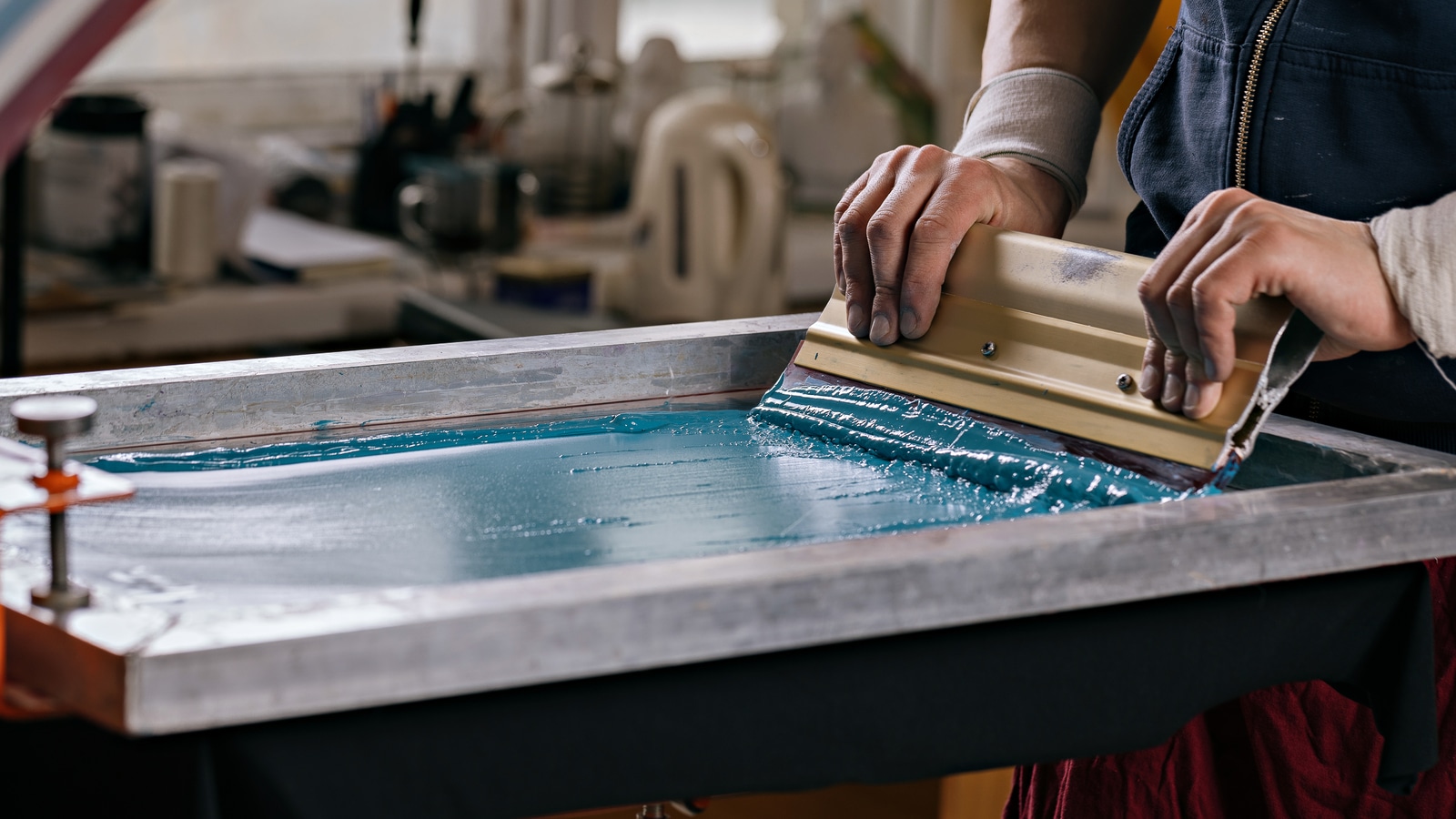Durable T-Shirt Printing for Everyday Wear
Durable T-Shirt Printing for Everyday Wear
Blog Article
Display Printing Uncovered: Everything You Need to Know Concerning Tee Shirt and Garment Printing Techniques
Display printing is a remarkable technique that combines art with method, providing endless possibilities for creativity. Ready to explore the vital aspects that make display printing an art type?
The Basics of Display Printing: Exactly How It Works
When you dive into screen printing, you'll discover it's both a scientific research and an art. At its core, screen printing includes producing a pattern, or display, that allows ink to pass via only in specific areas.
Position the screen over the material, after that use a squeegee to push ink with the display onto the garment. Each action is necessary, and mastering them will certainly boost your screen printing abilities, changing basic garments right into unique, expressive pieces.
Kinds of Display Printing Techniques
As soon as you grasp the fundamentals of screen printing, it's time to check out the different methods that can elevate your designs. One prominent technique is traditional screen printing, where ink is pressed through a stenciled display. This strategy is fantastic for bold, lively colors. There's water-based ink printing, which offers a softer feeling and is green, but it calls for a various technique to healing.
If you're going for great details, take into consideration discharge printing. This method removes color from the fabric, leaving a soft, classic look. Another option is plastisol printing, recognized for its resilience and vivid shades, making it a preferred for many brands. Experiment with halftone printing to produce slope impacts and elaborate designs. Each strategy has its special appeal, so don't be reluctant to try them out to locate what fits your design best!
Important Equipment for Display Printing
To accomplish magnificent results in display printing, having the appropriate tools is basic. You'll require a strong display printing framework, which holds the mesh that transfers your design onto the garment. Next, invest in premium mops; these are crucial for using ink equally throughout the display.
Picking the Right Inks and Materials
When choosing inks and materials for display printing, you need to think about the type of ink that works ideal for your task. Think of fabric compatibility to assure your layouts look last and wonderful lengthy. Explore green ink choices to make your printing process extra lasting.
Sorts Of Display Inks
Selecting the right display ink is essential for attaining lively, resilient prints that fulfill your task's needs. There are numerous kinds of screen inks to analyze. Plastisol ink is prominent for its versatility and simplicity of use, offering excellent shade opacity on dark textiles. Water-based ink, on the various other hand, supplies a softer feeling and is environment-friendly, making it optimal for those seeking to decrease their ecological influence. Release inks eliminate color from the fabric, resulting in a soft, classic appearance yet require specific handling. Specialized inks, such as glow-in-the-dark or metal, can include one-of-a-kind effects to your styles. Evaluate your project demands and select the ink that aligns finest with your wanted end result.

Material Compatibility Considerations
Comprehending textile compatibility is important for attaining top notch display prints, specifically considering that various products react distinctively to different inks. Constantly examine your inks on sample fabric to assure they adhere effectively and maintain color honesty. Additionally, maintain in mind that textile weight and texture can impact the last outcome, so choosing the appropriate ink and material combo is essential for your job's success.
Eco-Friendly Ink Options
Environmentally friendly inks are coming to be a popular option for display printers who want to decrease their ecological impact while preserving high quality. When picking inks, consider water-based inks, which are less unsafe and simpler to clean up contrasted to traditional solvents. These inks bond well with fabrics, providing vivid outcomes without harmful chemicals. You may additionally discover eco-solvent inks that use fewer unstable natural compounds (VOCs), making them a more secure option for both your wellness and the planet.
Furthermore, seek inks made from renewable energies, such as soy or vegetable-based options. By choosing the appropriate inks and products, you'll not only create stunning layouts yet likewise add to a more lasting printing procedure. Make the switch, and your prints will certainly mirror your commitment to the environment!
Preparing Your Layout for Display Printing

File Format Requirements
To guarantee your layout looks sharp and dynamic on textile, you'll need to pay attention to submit layout requirements for screen printing. Begin with vector documents like AI or EPS, as they can be scaled without shedding quality. If you utilize raster photos, choose high-resolution files, such as TIFF or PNG, ideally at 300 DPI. Prevent making use of JPEGs, as they can shed clarity when resized. Make certain your layout has a transparent history to avoid undesirable white edges on your prints. Finally, keep shade modes in mind; CMYK is typical for screen printing, so convert your RGB designs accordingly. By complying with these guidelines, you'll set your artwork up for a successful print.
Shade Splitting Up Methods
Color splitting up is a crucial step in preparing your style for display printing, and mastering it can significantly enhance your print high quality. You'll require to break screen printing kit your layout into specific colors, as each shade calls for a different display throughout printing. This precision not just guarantees exact color depiction but additionally improves the printing procedure.
Resolution and Size
Accomplishing the very best results in display printing starts with ensuring your layout has the right resolution and size. Preferably, your art work ought to be at the very least 300 DPI (dots per inch) for sharp, clear prints. If you utilize lower resolution, your end product might look pixelated and amateur.
When it pertains to dimension, consider the dimensions of your print location. Layout your art work to match the final print size, ideally producing it in the real measurements you'll be publishing. In this manner, you'll avoid any type of unanticipated scaling concerns.
Constantly check your style in both vector and raster styles. Vector graphics can be scaled without losing high quality, making them suitable for display printing. Preparing correctly will guarantee your design looks impressive on every garment!
Step-by-Step Screen Printing Process
Display printing is a dynamic process that enables you to develop vivid layouts on different surface areas. To get started, you'll require a display, emulsion, and your chosen ink.
Put ink onto the display and utilize a squeegee to push the ink with the pattern onto the textile. Lift the screen thoroughly and allow the print completely dry. You've successfully display published your layout.
Tips for Effective Display Printing Projects
While you're diving right into your display printing jobs, keep in mind that preparation is crucial to success. Start by collecting all your products-- inks, screens, garments, and mops. A tidy workspace assists prevent unwanted mistakes, so clean prior to you begin.
Following, verify your artwork is high-resolution and appropriately sized for your garment. Evaluate your display for proper direct exposure and clean it completely to avoid spots. When mixing your inks, adhere to the producer's standards to achieve the appropriate consistency.
During printing, use also pressure with your squeegee for regular outcomes. Don't rush; take your time to validate each print fulfills your requirements. After printing, allow your garments completely dry completely before taking care of or packaging them.
Lastly, always maintain an example of your work for future referral. In this manner, you can examine your progress and enhance your strategies gradually. Satisfied printing!

Regularly Asked Inquiries
For how long Does It Take to Establish up a Display Printing Work?
Establishing up a screen printing job usually takes about thirty minutes to an hour. You'll prepare the displays, mix inks, and readjust the press. The time varies based upon intricacy and experience, so remain organized!
Can I Print on Different Fabric Types Using the Same Technique?
Yes, you can print on different material kinds making use of the same technique, however you'll need to change your setups and inks. Some fabrics soak up ink differently, so exploring assurances the most effective results for every material.
What Prevail Mistakes to Avoid in Screen Printing?
When display printing, stay clear of usual blunders like making use of the incorrect ink, disregarding correct exposure times, or missing pre-press checks. Always test your arrangement and maintain tidy screens to ensure high quality results each time.
Exactly How Can I Effectively Tidy and Preserve My Screen Printing Devices?
To properly tidy and preserve your display printing devices, you should regularly clean screens with ideal solvents, examine squeegees for wear, and guarantee all tools are saved dust-free and dry. Uniformity improves and avoids costly repair services performance.
Is Display Printing Ecologically Pleasant Contrasted to Other Techniques?
Display printing can be extra eco-friendly than various other approaches, especially if you utilize eco-conscious materials and water-based inks. By choosing sustainable materials and techniques, you lower waste and reduce your effect on the earth.
Display Printing Uncovered: Everything You Required to Know About Tee Shirt and Garment Printing Techniques
At its core, display printing entails creating a stencil, or screen, that allows ink to pass via just in particular areas. Placement the display over the material, then use a squeegee to press ink via the display onto the garment. One popular method is standard screen printing, where ink is pressed through a stenciled screen.When picking inks and products for screen printing, you need to take into account the kind of ink that functions finest for your project.
Report this page